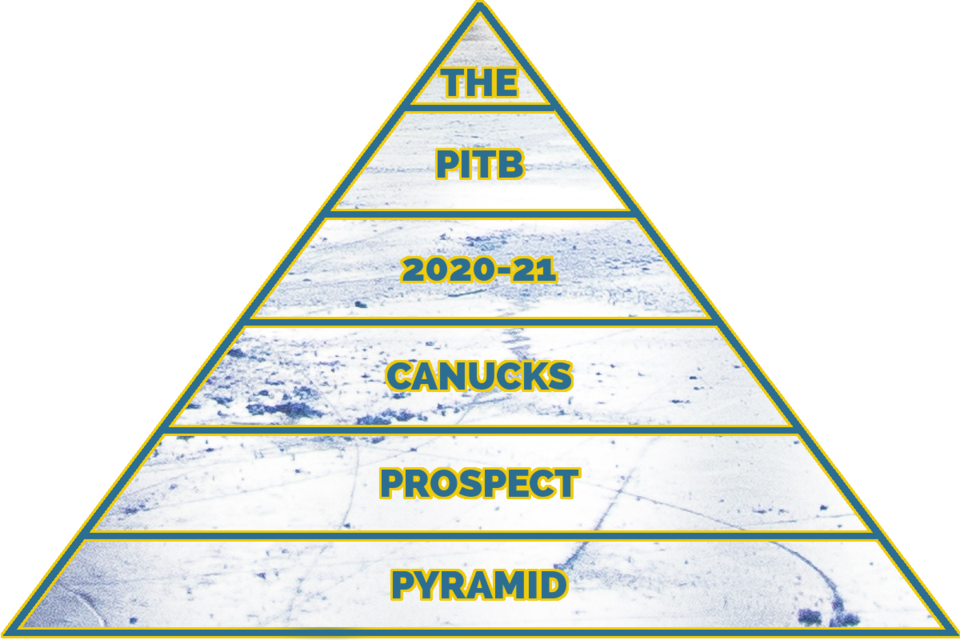The food pyramid had the right idea. Well actually, it had the wrong idea — lots of wrong ideas, really, based on a lot of outdated — but it did have the right shape. Pyramids are cool.
That’s why, beginning with last season, I started ranking the Canucks’ prospects using a pyramid. , the prospect pyramid is a better way to rank prospects, as it doesn’t require trying to differentiate between the Canucks’ 12th or 13th-best prospects, but instead sorts them into tiers.
The pyramid is more narrow at the top because a team will always have fewer blue chip prospects. As you move down the pyramid, it widens, making room for all of the prospects in the system, rather than trying to rank one above the other. Which of the Canucks’ prospects is 19th best and which is 20th best? Who cares? They both go in the same tier.
Let’s get started.
Tier 1
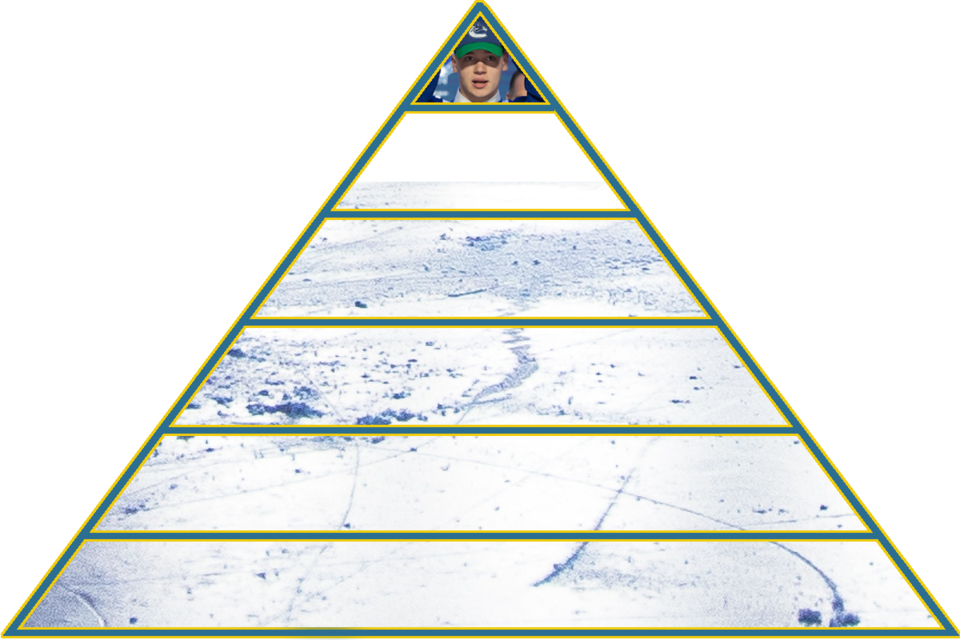 2020-21 Canucks Prospect Pyramid: Tier 1
2020-21 Canucks Prospect Pyramid: Tier 1The top tier is for true, blue-chip prospects: Quinn Hughes was alone in Tier 1 last season and that turned out to be very, very accurate, as he quickly established himself as one of the best defencemen in the NHL.
Even having a prospect in the top tier might seem odd, but I’m a big-time believer in Vasily Podkolzin. He has the potential to be a first-line power forward that forechecks, wins puck battles, defends, and racks up goals. He may not turn out to be a superstar in the sense of Hughes or Elias Pettersson, but he could be nearly as impactful with his strong two-way game. Pettersson could win a Hart Trophy, Hughes could win the Norris, but Podkolzin has the potential to win a Selke.
There’s no one else like Podkolzin in the Canucks system; in fact, few systems have a player like Podkolzin, which is why I put him in the top tier instead of the second.
Sure, he’s not racking up points in the KHL, but if his KHL team doesn’t want to take full advantage of his incredible skillset and give him ice time while they still have him, that’s their loss.
Tier 2
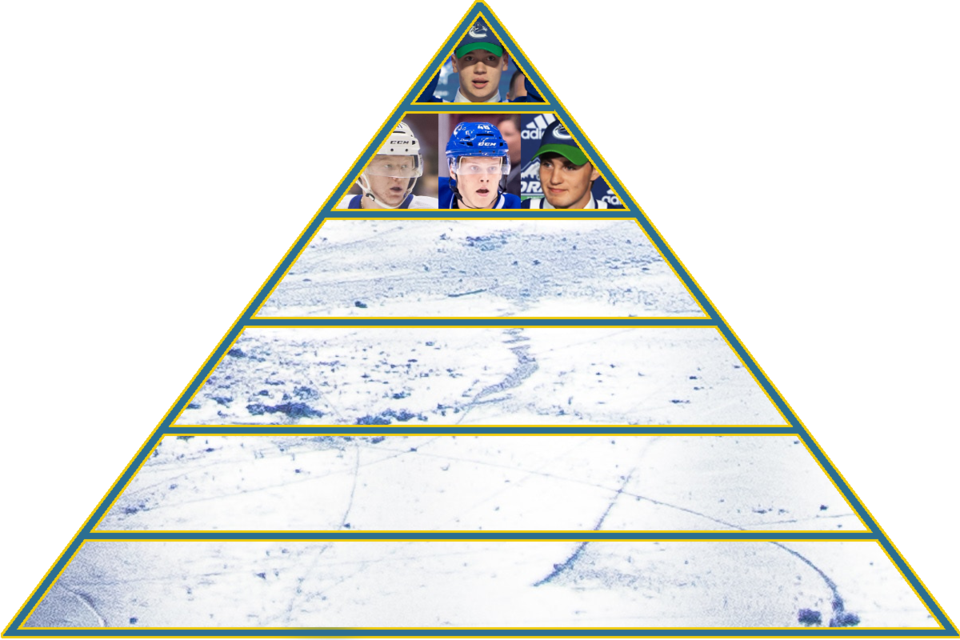 2020-21 Canucks Prospect Pyramid: Tier 2
2020-21 Canucks Prospect Pyramid: Tier 2These are good prospects in the second tier, players that could be top-six forwards, top-four defencemen, or solid starting goaltenders. They’re unlikely to be superstars like the top tier but are still great prospects in their own right.
Jack Rathbone is coming off two fantastic seasons for Harvard University, putting up a total of 53 points across 61 games. Last season was particularly impressive, as he tallied 31 points in 28 games without his excellent defence partner from his freshman year, Adam Fox, who just had a fantastic rookie season with the New York Rangers.
Offensively, Rathbone has all the tools to be an impact player in the NHL. He’s a phenomenal skater, has a wicked shot, and has great on-ice vision. It’s not hard to see him stepping up to quarterback the second power play unit behind Hughes in the future. The question is whether he can defend effectively against NHL-caliber talent.
I’m going to show some faith in Olli Juolevi and trust in the work that he’s put in with the Utica Comets over the last few years and that he’s truly 100% healthy in order to keep him in the second tier. Juolevi will almost certainly be in the NHL next year and one of the big reasons why is his ability to play on the penalty kill, something that sets him apart from some of the other Canucks’ prospects vying for a spot on the blueline next season.
Juolevi still has the potential to be a top-four defenceman, even if injuries have set back his development. He’s a great puck-mover, making difficult stretch passes look easy, and he’s a very smart player. The biggest issue for him is defending off the rush, as his pivots are awkward and slow. If he doesn’t address that issue, NHL forwards will eat him alive, but he did take steps forward with his skating towards the end of last season and didn't look out of place in his one game for the Canucks during the playoffs.
There are some people who think that Nils Höglander is the best prospect in the Canucks system. Those people are wrong, but it’s understandable why they would think that. Höglander combines incredible hands and dynamic scoring ability with an incredible motor, constantly working and competing to win the puck, protect it, and get it into a dangerous scoring area.
His offensive skill obviously jumps out and he has 9 points in 14 games in the SHL so far this season, but he’s committed defensively as well. Höglander has legitimate top-six upside.
Tier 3
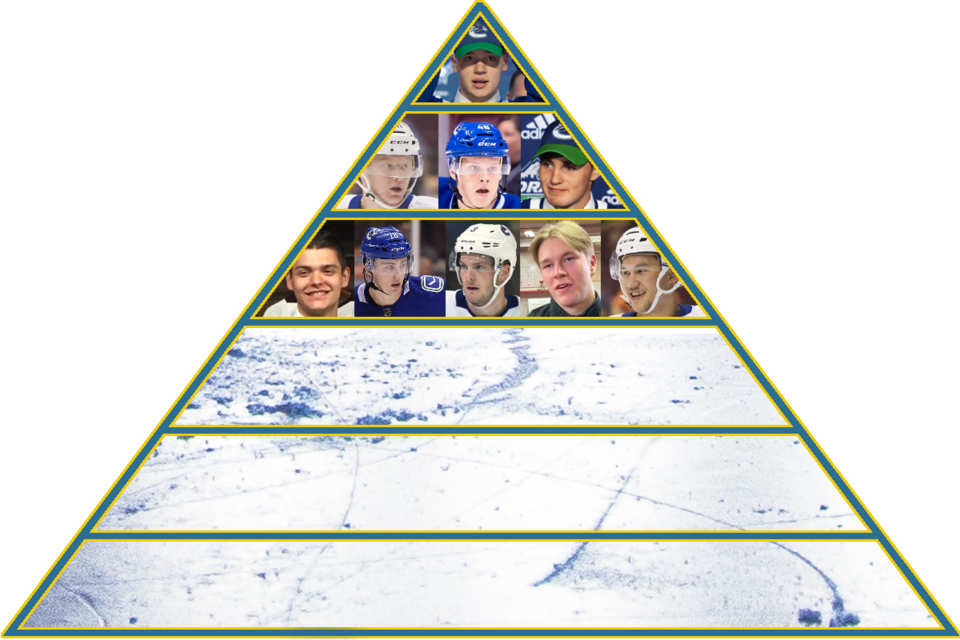 2020-21 Canucks Prospect Pyramid: Tier 3
2020-21 Canucks Prospect Pyramid: Tier 3As we get into the third tier, we’re looking at prospects that are more likely to become bottom-six forwards, bottom-pairing defencemen, or backup goaltenders. Some from this tier could surprise and be better than expected; some won’t make the NHL at all.
Michael DiPietro is the Canucks’ top goaltending prospect. He’s a competitive kid who never gives up on a play, which works well with his excellent speed, agility, and flexibility. He was the youngest starter in the AHL last season at just 20 years of age and maintained a save percentage right around league average for a team that didn’t always defend well.
Will DiPietro be able to take his game to the NHL, where shots are harder and more accurate? That remains to be seen, but he’s a good bet to at least be an NHL backup in the future.
Kole Lind is a : he chirps, he hacks, he agitates, and he gets under the skin of his opponents. He also has impressive hands and playmaking ability and took a big step forward in his second year in the AHL, putting up 44 points in 61 games.
While Lind is unlikely to be a top-six forward in the NHL, his agitating game could make him a solid third-line winger.
Brogan Rafferty is nearing the point where he’s too old to be a prospect, having turned 25 in May. While he was a rookie in the AHL last season, he was an older rookie. And yet, what a rookie season it was: he led all rookie defencemen with 45 points in 57 games and was third among all AHL defencemen in scoring.
Clearly, the offensive aspect of Rafferty’s game is solid; the question marks lie with his defensive game, where he might have trouble at the NHL level. Still, on a team with limited depth on the right side, Rafferty is an important prospect for the Canucks.
Joni Jurmo was the Canucks’ top pick in the 2020 NHL Entry Draft, albeit not until the third round, as they didn’t have a first or second-round pick. He’s still an intriguing prospect, even if every scouting report seems to emphasize just how raw and unrefined he is as a player.
Skating is clearly Jurmo’s best attribute, as he can flat-out fly up the ice. He’s at his best when he’s carrying the puck through the neutral zone, attacking with speed. He combines that speed with some serious size, standing 6’4” and weighing in at 198 lbs. Jurmo still needs a lot of development, particularly on the defensive side of the ice, but he has an intriguing skillset.
Adding to the right-side on defence, Jett Woo has the hard-hitting physical game to bring a different dimension to the Canucks’ defensive depth, but matches that with a well-rounded game. He skates well, can pass the puck, and has great vision on the ice for a defensive defenceman.
Woo did take a step back last season in the WHL, only putting up 46 points after a 66-point season in his post-draft year, but that’s less of a concern for Woo, who projects as a stay-at-home, bottom-pairing defenceman that makes life difficult for opposing forwards.
Tier 4
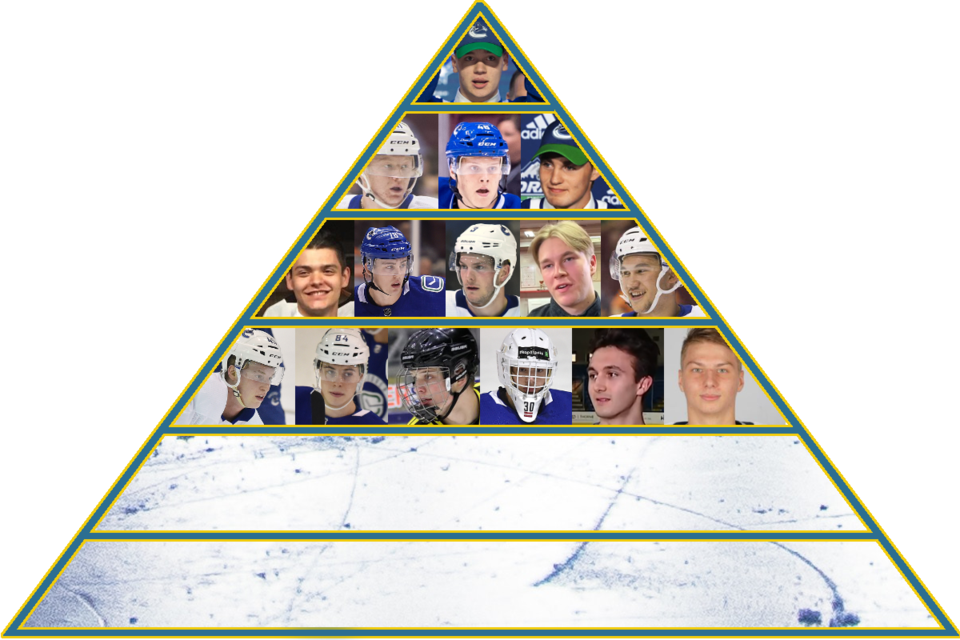 2020-21 Canucks Prospect Pyramid: Tier 4
2020-21 Canucks Prospect Pyramid: Tier 4There are still players in the fourth tier that could make an impact in the NHL. Some of them are prospects I quite like and that could move up the pyramid in the future — Jack Rathbone, now in Tier 2, was in Tier 4 last year before his excellent sophomore season in the NCAA. These players definitely represent longshots, however, and the odds are a bit stacked against them.
The Canucks are high on Carson Focht, liking his mature, hard-working defensive game. In a system with few centres, Focht is arguably their best one and could have a future as a defensive, bottom-six forward. The issue is that he wasn’t even a point-per-game player in the WHL when he already turned 20 in February, which is a concern.
Even bottom-six forwards in the NHL need a base level of skill and poise with the puck, which usually translates into points at lower levels. Focht had 32 goals and 56 points in 61 games, which is fine, but it does lead to questions about how he’ll handle faster hockey at higher levels.
Aidan McDonough is intriguing with his power forward’s frame and excellent shot. He put up 27 points in 31 games as a 20-year-old freshman at Northeastern University, which is respectable production. Can he continue producing at that level — or take a step forward — without Tyler Madden setting him up?
Viktor Persson is one of the most interesting picks from the Canucks’ 2020 draft class. The 7th-round pick was under-scouted as a Swedish defenceman without international experience whose season in the under-20 SuperElit league was shortened by injury.
Persson’s skating and playmaking are high-end and he has the tools to be a solid two-way player as well. He has real potential to play in the NHL, though the Canucks will have to be patient. Team Sweden seems to see it as well: he was a late addition to Sweden’s U-20 roster for a tournament that ultimately was cancelled, but it shows he’s on their radar for the World Junior Championships.
Arturs Silovs is second on the depth chart for the Canucks’ goaltending prospects. He’s coming off a rough season with the Barrie Colts in the OHL, but has been fantastic in Latvia to start this season, both in league and international play. He’s big and athletic, but needs some refinement in his overall technique.
Like Persson, Jacob Truscott is a defenceman taken in the later rounds by the Canucks at the 2020 draft. Also like Persson, he was a little under the radar as he was overshadowed by his teammate on the U.S. National Team Development Program, Jake Sanderson. Truscott is a great skater and passer; the trouble is a lack of consistency that will need to get ironed out if he is to have an NHL future.
Finally, there’s Dmitri Zlodeyev, who might have the best odds of moving up the pyramid of all the prospects in this tier. The Canucks’ sixth-round pick in 2020 is a competitive, hard-working, two-way centre, who has the potential to develop into a bottom-six centre at the NHL level. At the same time, there are flashes of high-end skill and playmaking in his game that suggest he might have a little more upside.
Tier 5
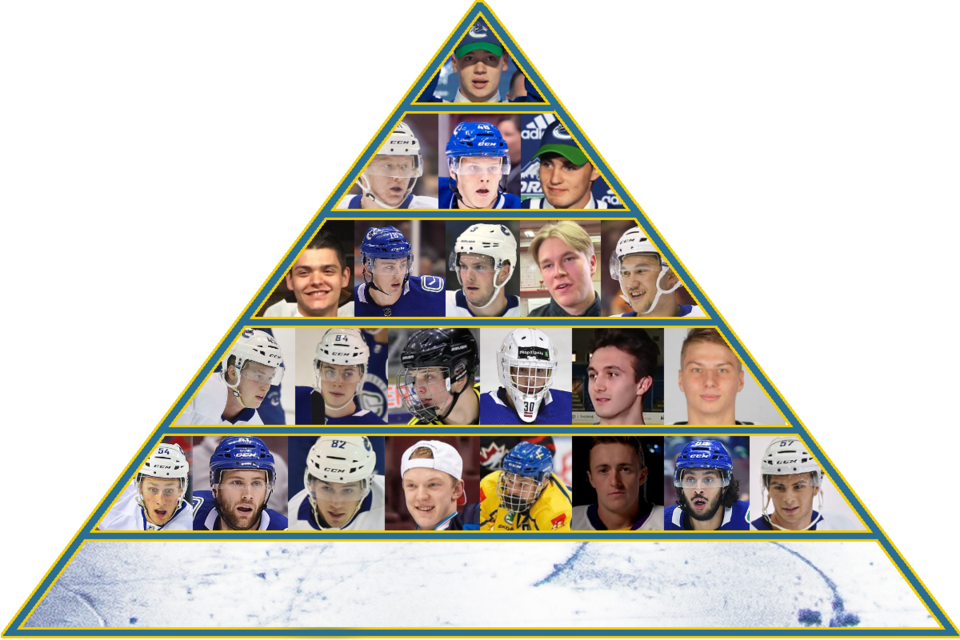 2020-21 Canucks Prospect Pyramid: Tier 5
2020-21 Canucks Prospect Pyramid: Tier 5The fifth tier features a few players that will almost certainly play NHL games in the future. One of them already has played NHL games. What keeps them from Tier 4 is that they’re unlikely to stick long term in the NHL. As always, a prospect could take significant steps forward in their development and move up a tier or more.
Guillaume Brisebois already has 8 NHL games under his belt and he’s been a common call-up when the Canucks have injuries. While Juolevi and Rathbone are far better prospects than Brisebois, it’s still possible that Brisebois will get into some NHL games in the coming season. I just don’t see an NHL defenceman when I watch Brisebois play, but there’s a reason he keeps getting opportunities and he could very well prove me wrong.
Jonah Gadjovich tripled his goal totals in the AHL last season, but he still had just 13 goals and 17 points in 38 games, which isn’t what you want to see from a 22-year-old prospect that still has question marks surrounding his skating. Still, he's got the grit and size, as well as the finish around the crease, to play in front of the net in the NHL. Now it's a matter of putting together the other aspects of his game. He's got to improve his skating, particularly his acceleration, to make the most of his size at the NHL level.
Jack Malone might have been as likely as Costmar to move up the pyramid if it wasn't for his season with Cornell University getting cancelled. As it is, Malone won’t have the opportunity to improve on his 8 points in 27 games in his freshman year.
It’s a shame, as Malone has legitimate upside with his speed and nose for the net. For the time being, he’ll stay in Tier 5.
Toni Utunen is a solid, if unspectacular defenceman from Finland. Utunen provides little-to-no offence, but is smart and positionally sound defensively, using his skating to make up for his smaller size. He’s proven that he can defence against men — he played his first game in the Finnish Liiga when he was still just 16 years old — but he still needs to show that he can move the puck at a high level as well.
Arvid Costmar has a higher ceiling than some of the other players in this tier, but a lower likelihood of reaching that ceiling. Costmar has dominated in Swedish junior hockey, putting up 26 goals and 50 points in 29 games last season and 6 points in 3 games this season. At higher levels, however, he’s been kept quiet, and he needs to show that he’s dynamic enough for his skill to shine through at the pro level.
Costmar is likely to play with Team Sweden at the World Junior Championships, where he’ll have the opportunity to prove himself against his peers. He could jump up a tier or two in the future.
While he may not be the best centre in the Canucks’ system, Marc Michaelis is the only one likely to play in the NHL next season. Michaelis was one of the best players in the NCAA last season, putting up 44 points in 31 games.
The issue is that Michaelis is already 25 years old — already bordering on not being considered a prospect — so has limited time to prove himself as a possible NHL centre. The Canucks lack of depth at centre certainly improves his odds, as does his well-rounded two-way game and playmaking ability. He could see some spot action with the Canucks if injuries strike.
Like Brisebois, Jalen Chatfield could get some NHL games because his defence-first game — really, defence-only — could make him attractive to a Canucks’ team missing Chris Tanev. Chatfield skates well and is committed in the defensive zone, but has limited puck skills that lower his ceiling significantly. There’s a possibility that Chatfield could stake out a spot on a bottom-pairing at the NHL level, but it’s a slight one.
William Lockwood has the elements to his game to be a third-line winger: he’s fast and he likes to hit, making him strong on the forecheck. There are some red flags: he’s been injury prone, which is a concern with his hard-hitting game, and his game took a step back offensively last season. Can he still be an effective physical player in the NHL with his injury history? If he can, he could be a valuable depth piece for the Canucks; if not, he’ll likely stay in the AHL.
Tier 6
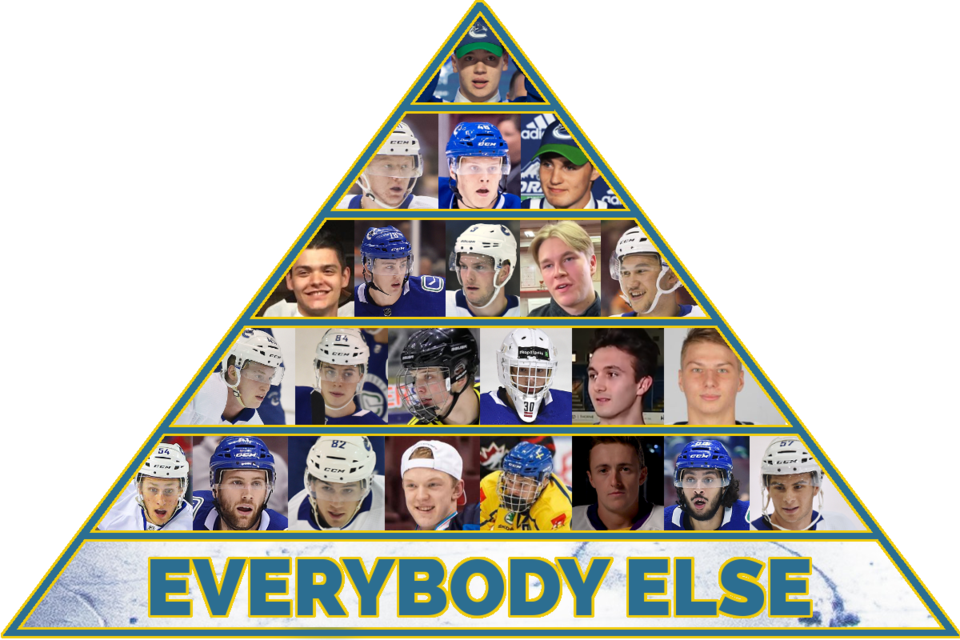 2020-21 Canucks Prospect Pyramid: Tier 6
2020-21 Canucks Prospect Pyramid: Tier 6This is the tier for everyone else in the system.
That’s not to say that everyone in this tier is terrible or has no hope of making the NHL. All of the prospects in the Canucks’ system are among the best hockey players in the world. This just means the odds of them making the NHL are pretty low.
Linus Karlsson leads all under-22 players in the Allsvenskan in scoring with 16 points in 17 games, but that also means he’s 21 years old and still playing in the Allsvenskan rather than the SHL.
Jackson Kunz can put the puck in the net and has power forward potential, but his skating might never let him reach that potential.
They're down with the rest of the prospects in the Canucks system who are fighting against the current to make the NHL: Ethan Keppen, Lukas Jasek, Karel Plasek, Artyum Manukyan, Petrus Palmu, and Mitch Eliot, Ashton Sautner, and Josh Teves, as well as goaltenders Jake Kielly and Matthew Thiessen.
Some players that were in this tier last year have been bumped up the pyramid, like Costmar, McDonough, and Focht. Perhaps players like Kunz and Karlsson can do the same.
What do you think of this year’s prospect pyramid? Who do you think needs to be knocked down or bumped up a tier? Let me know in the comments below.
